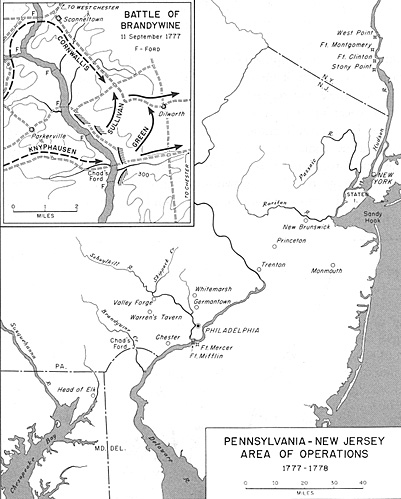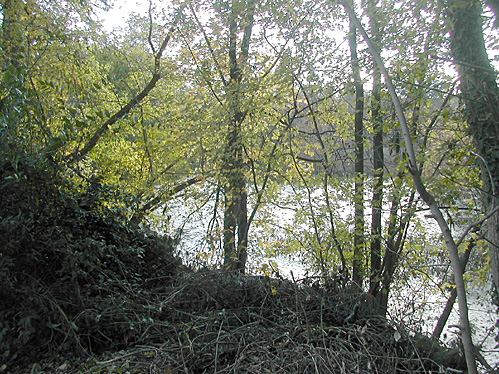
When Howe finally began to stir in June 1777, Washington posted his army at Middlebrook, New Jersey, in a position either to bar Howe's overland route to Philadelphia or to move rapidly up the Hudson to oppose an advance northward. Washington confidently expected Howe to move northward to form a junction with Burgoyne, but decided he must stay in front of the main British Army wherever it went. Following the principle of economy of force, he disposed a small part of his army under General Putnam in fortifications guarding the approaches up the Hudson, and at a critical moment detached a small force to aid Schuyler against Burgoyne. The bulk of his army he kept in front of Howe in an effort to defend Philadelphia. Forts were built along the Delaware River and other steps taken to block the approach to the Continental capital by sea.
In the effort to defend Philadelphia Washington again failed, but hardly so ignominiously as he had the year before in New York. After maneuvering in New Jersey for upward of two months, Howe in August put most of his army on board ship and sailed down the coast and up the Chesapeake Bay to Head of Elk (a small town at the head of the Elk River) in Maryland, putting himself even further away from Burgoyne. (Map 7) Though surprised by Howe's movement, Washington rapidly shifted his own force south and took up a position at Chad's Ford on Brandywine Creek, blocking the approach to Philadelphia. There on September 11, 1777, Howe executed a flanking movement not dissimilar to that employed on Long Island and again defeated Washington.
The American commander had disposed his army in two main parts, one directly opposite Chad's Ford under his personal command and the other under General Sullivan guarding the right flank upstream. While Lt. Gen. Wilhelm von Knyphausen's Hessian troops demonstrated opposite the ford, a larger force under Lord Cornwallis marched upstream, crossed the Brandywine, and moved to take Sullivan from the rear. Washington lacked good cavalry reconnaissance, and did not get positive information on Cornwallis' movement until the eleventh hour. Sullivan was in the process of changing front when the British struck and his men retreated in confusion.
Washington was able to salvage the situation by dispatching General Greene with two brigades to fight a valiant rear-guard action, but the move weakened his front opposite Kynphausen and his forces also had to fall back. Nevertheless, the trap was averted and the Continental Army retired in good order to Chester.
September 9, 1777
Washington Prepares Defenses
Philadelphia, the capital of the newly formed nation, was the goal of British General Howe during the campaign of 1777. The British approached Philadelphia from the Chesapeake, landing at Head of Elk, Maryland, present day Elkton. As the British began their march toward the city, Washington and the people of Philadelphia were confident that the British could be stopped. Washington chose the high ground in the area of Chadds Ford to defend against the British advance. Chadds Ford allowed safe passage across the Brandywine River on the road from Baltimore to Philadelphia.
On the morning of September 9th Washington placed his troops along the Brandywine River to guard the main fords. By placing detachments of troops at Pyle's Ford-the southernmost posssible crossing of the river and Wistar's Ford-the northernmost crossing of the river before it forkedWashington hoped to force a fight at Chadds Ford, an advantageous position. Washington believed that he had all of the fords along the Brandywine guarded by his troops and that the closest unguarded ford was twelve miles up-river. Washington was confident that the area was secure.
The British grouped at nearby Kennett Square and formulated a plan. A portion of the British army was to march from Kennett Square as if they intended to meet Washington on the banks of the river at Chadds Ford. Meanwhile, the majority of the army under Howe's direction would march north of Wistar's Ford, cross the river at a ford unknown to Washington, and march south into the flank of the American forces. Superior tactics and better knowledge of the area allowed the British to outwit Washington and his army.
What excessive fatigue. A rapid march from four o'clock in the morning till four in the eve, when we engaged. Till dark we fought ....There was a most infernal fire of cannon and musquetry. Most incessant shouting. 'Incline to the right! Incline to the left! Halt! Charge!' etc.. The balls plowing up the ground. The trees cracking over one's head. The branches riven by the artillery. The leaves falling as in autumn by the grapeshot.
- --A British officer's comments on the battle.
September 11, 1777
Americans Defeated at Brandywine
The day of the battle began with a heavy fog which blanketed the area, providing cover for the approaching British troops. When the fog cleared, the sun blazed and the heat was sweltering. The first reports of British troop movements indicated to Washington that Howe had divided his forces. Subsequent reports both confirmed and denied this report. In the confusion Washington persisted in the mistaken belief that the British were wending their entire force against his line at Chadds Ford.
Meanwhile, Howe and the majority of his force continued their approach. By mid-afternoon the British had crossed the river at the unguarded ford to the north of Washington's force and they had gained a strategic position near Birmingham Friends Meeting House.
When the British appeared on the American right flank, Washington realized that he had been outmaneuvered. He ordered his army to take the high ground around Birmingham Friends Meeting House as a last defense. Unfortunately, in the confusion caused by the surprise, the Americans were unable to successfully defend their position. The Americans fought valiantly, but they had been outwitted on the rolling hills along the Brandywine.
Nightfall finally brought an end to the battle. The defeated Americans retreated to Chester. The bulk of the army arrived by midnight with the remainder trickling in until dawn. General Howe's exhausted men camped on the battlefield and the surrounding countryside including the farmyards of Benjamin Ring and Gideon Gilpin. British Captain John Andre wrote in his journal, "Night and the fatigue the soldiers had
LAFAYETTE' S QUARTERS
Notwithstanding the misfortune of the day, I am happy to find the troops in good spirits.
- --Washington to Congress after the Battle of Brandywine.
September 26, 1777
The British Take Philadelphia
Although the American army was forced to retreat after the Battle of Brandywine, the defeat did not demoralize the men. They believed the defeat was not the result of poor fighting ability but rather because of unfamiliarity with the landscape and poor reconnaissance information.
During the next several days, General Howe and his Army moved closer to Philadelphia with little opposition from Washington. The two armies maneuvered in hopes of finding the other at a disadvantage, but no decisive military actions were taken during the next two weeks. Congress abandoned Philadelphia and moved first to Lancaster and then to York to escape before the British takeover. Important military supplies were moved out of the Philadelphia area to Reading, Pennsylvania, where they could be defended.
Washington responded cautiously after the battle. The impending loss of Philadelphia hurt the patriot cause, and Washington's force had dropped from a high of nearly 15,000 prior to the battle to only 6,000. Washington wrote to Alexander Hamilton on the 22nd, "The distressed situation of the army, for want of blankets and many necessary articles of clothing, is truly deplorable, and inevitably must bring destruction to it, unless a speedy remedy is applied." Local leaders did what they could to supply the army with food and clothing. Reinforcements sent by Congress began to arrive, and Washington felt the army was sufficiently ready to mount an attack. However, it was too late to save Philadelphia, for on September 26th a column of British soldiers marched into the patriot capital unopposed.
Chadd's Ford, adjacent to Rte 1 bridge

Battle of Brandywine: Sep 11, 1777
- Introduction and Driving Tour
The Battle
The Battlefield Today
Washington's HQ (Benjamin Ring House)
Lafayette's HQ (Gideon Gilpin House)
The Sanderson Museum
Back to List of Battlefields
Back to Travel Master List
Back to MagWeb Master List of Magazines
© Copyright 2003 by Coalition Web, Inc.
This article appears in MagWeb (Magazine Web) on the Internet World Wide Web.
Other articles concerning military history and related topics are available at http://www.magweb.com